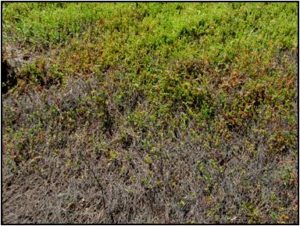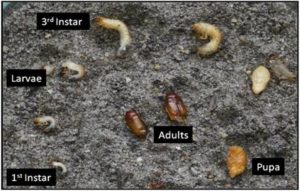Fruit Crops Edition
Seasonal updates on diseases, insects, weeds impacting tree fruit and small fruit (blueberry, cranberry, and wine grape). Fruit Pest Alerts are also available via this category feed.
Subscriptions are available via EMAIL and RSS.
Revised New Jersey Pesticide Regulations — NOW POSTED ONLINE!
Gov. Murphy to Sign Order Requiring Outdoor Face Coverings
As reported at njbiz.com Wednesday morning, NJ Governor Phil Murphy has indicated he will be signing “an executive order mandating that masks or other face coverings be worn outdoors, as the COVID-19 virus surges across the country and the transmission rate creeps up in New Jersey.”
The state currently requires the use of face coverings indoors and at many outdoor businesses, and strongly encourages their use when in crowded public spaces, such as at the beach. The new order will require that masks will have to be worn outdoors when social distancing is not possible.
There are many outdoor operations around the farm. Be sure to plan accordingly with supplies of masks/face coverings for all agricultural workers and harvesters, in addition to planning all field work with adequate space for individuals to keep socially distanced.
For more information on keeping you, your workers and your family safe, be sure to read and implement the recommendations in NJ’s “INTERIM CORONAVIRUS DISEASE 2019 (COVID-19) GUIDANCE FOR MIGRANT AND SEASONAL FARMWORKERS, THEIR EMPLOYERS, AND HOUSING PROVIDERS.”
NJDEP Notice: Delayed Processing of Applications and Other Requests Due to July COVID-19 Furloughs
Fruit IPM For 7/7/20
Spotted Lanternfly in apple orchards…. [Read more…]
RCE Agents Offer Marketing Tips With Del State U & USDA Northeast Climate Hub
Webinar Postponed ’til Fall!
Due to technical issues and low enrollment, this webinar has been postponed by the organizers and will be rescheduled for the fall.
Register here today (7/7/20) by 11pm!
Webinar: Part 2 in a series
Emergency Preparation & Dealing with COVID-19 on Farms: Alternative Marketing Strategies to Stay in Business
Wednesday, July 8, 2020
Time: 12 – 1:15 PM
Use the link below to register by July 7, 2020, 11 PM EST. The Zoom link to the webinar will be e-mailed to all registered attendees prior to the webinar.
[link removed]
Small farmers and extension agents working with small farmers will learn best practices for communicating with consumers and meeting their demands.
Participants will learn how to:
- Use available resources to market your products
- Reach out to consumers online
- Use alternative marketing strategies to sustain and grow businesses
- Use online business opportunities for farm sales
Attendees will learn about available resources to help them manage logistics of the Covid-19 health crisis on their farms. Presenters will share information and solutions from the experts and answer questions from participants. Like the first webinar in this series, this meeting will address common problems most farmers are facing, what they are planning to do to stay in business and how well their plans are working. The webinar series also summarizes how extension programs can assist farmers through this difficult time.
Agenda (Q&A session after each presentation)
| 12 – 12:05 PM | Welcome & Introduction | Gulnihal Ozbay & Jason Challandes, DSU; Erin Lane, USDA Northeast Climate HUB |
| 12:05 – 12:25 PM | “Know Your Customers Know Your Prices” |
Richard VanVranken, Professor & County Extension Department Head (Small Farms & Farm Marketing), Rutgers Cooperative Extension of Atlantic County, New Jersey |
| 12:25 – 12:45 PM | “Meeting Customer Demands for Agricultural Products In response to the Covid-19 Pandemic” |
Stephen Komar, Associate Professor & Agriculture & Natural Resources County Agent II, County Extension Department Head (Plant and Animal Agriculture), Rutgers Cooperative Extension of Sussex County, New Jersey |
| 12:45 – 1:05 PM | “Online logistics and considerations with Direct Sales Models during Covid-19” | William J. Bamka, Associate Professor & Agriculture & Natural Resources County Agent II, County Extension Department Head of Rutgers Cooperative Extension of Burlington County in New Jersey, Crop Production and Agritourism |
| 1:05 – 1:15 PM | Closing Remarks & Information on Webinar Evaluation |
Dr. Ozbay and Ms. Lane |
This webinar series is moderated by Delaware State University Cooperative Extension (Dr. Gulnihal Ozbay) & USDA Northeast Climate Hub (Erin Lane). Webinar hosts are Ms. Megan Pleasanton & Mr. Jason Challandes (DSU Cooperative Extension).
Post-Pollination Insect Control
If needed, post-pollination sprays (particularly for Sparganothis fruitworm and spotted fireworm) should be applied as soon as bees are removed; ideally before 11 July. Sparganothis fruitworm is monitored with pheromone traps to assess adult flight pattern and their abundance. If you had high trap counts of this pest and have not used an insecticide treatment yet you should consider treating soon to prevent damage to berries. Your post-pollination options include Diazinon, Exirel, Altacor, or Delegate.
Root-feeding insects and use of Imidacloprid
If your cranberry beds have damage caused by root feeding insects, you should consider treatment with imidacloprid (Admire Pro and other generics) immediately after bees are removed (mid-July). Dead plant patches indicate the presence of root-feeding insects (Figure 1). Pull dead vines and search through the root zone and soil for grubs. Imidacloprid is labeled for the control of rootworm, root grub (Phyllophaga spp.) (Figure 2), and other scarabs in cranberries. This insecticide is a contact and stomach poison that affects the insect nervous system. It is highly systemic and toxic to honey bees; therefore, can be used only as a post-pollination insecticide. This insecticide can be applied by ground or by chemigation. Aerial application of this product is prohibited. Admire Pro has a long residual activity (> 100 days) as long as the insecticide is not directly exposed to the sun and can be used at 7-14 fl oz/acre. A maximum of 14 fl oz of Admire Pro can be used per acre per season. Irrigate target area with 0.1 to 0.3 inches before and after the application of imidacloprid. The pre-harvest interval is 30 days. Most scarab grubs in cranberries have multi-year life cycles; consequently, you may not be able to suppress a population of 2- and 3-year life cycle grubs with a single application. You may have to use imidacloprid two to three years in a row for most effective suppression. For this reason, it is useful to know what species you have before using imidacloprid. See “Cranberry Insects of the Northeast” (authors: Averill and Sylvia) for information on how to identify common grub species in cranberries.

Figure 1. Damage caused by Phyllophaga grubs

Figure 2. Phyllophaga grubs
